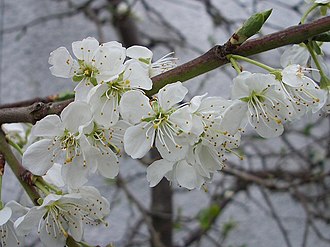Victoria plum


Victoria plum is a variety of plum that was first cultivated in England in the early 19th century. Named after Queen Victoria, the Victoria plum has since become one of the most famous and widely grown plum varieties in the United Kingdom and has gained popularity in various parts of the world. The fruit is known for its distinctive sweet flavor, making it a favorite for fresh consumption, cooking, and preservation.
Description[edit]
The Victoria plum tree is a medium-sized tree that typically bears fruit in late summer. The plums themselves are medium to large in size, with a smooth, reddish-yellow skin that often has a mottled appearance. The flesh of the Victoria plum is yellow, very juicy, and sweet, with a small stone that separates easily from the fruit, making it excellent for eating fresh as well as for cooking and baking.
Cultivation[edit]
Victoria plums thrive in temperate climates and are particularly well-suited to the British weather, where they have become a staple in gardens and orchards. They require well-drained, fertile soil and benefit from full sun exposure to produce the best fruit. The trees are self-fertile, meaning they do not require a pollinator to produce fruit, although cross-pollination can increase yield. Pruning is essential to maintain the health of the tree, encourage growth, and maximize fruit production.
Uses[edit]
The versatility of the Victoria plum makes it a popular choice for a variety of culinary uses. It is delicious eaten fresh and is also widely used in cooking and baking. Victoria plums are often used to make jams, jellies, and preserves due to their high sugar content and flavorful juice. They are also a popular choice for desserts, such as pies, crumbles, and tarts. In addition to culinary uses, Victoria plums can be used to make plum wine and other fruit-based alcoholic beverages.
Cultural Significance[edit]
The Victoria plum holds a special place in British horticulture and cuisine. It is often associated with the late summer and early autumn months, a time when the plums are harvested and celebrated in various food festivals and culinary events across the country. The variety's connection to Queen Victoria and its long-standing presence in British gardens and orchards add to its cultural significance.
Conservation[edit]
While the Victoria plum remains popular, like many traditional fruit varieties, it faces challenges from commercial pressures and changing agricultural practices. Conservation efforts focus on preserving genetic diversity, promoting traditional and organic cultivation methods, and encouraging the planting and maintenance of Victoria plum trees in gardens and orchards across the UK.

This article is a agriculture stub. You can help WikiMD by expanding it!
Ad. Transform your life with W8MD's Budget GLP-1 injections from $75


W8MD offers a medical weight loss program to lose weight in Philadelphia. Our physician-supervised medical weight loss provides:
- Weight loss injections in NYC (generic and brand names):
- Zepbound / Mounjaro, Wegovy / Ozempic, Saxenda
- Most insurances accepted or discounted self-pay rates. We will obtain insurance prior authorizations if needed.
- Generic GLP1 weight loss injections from $75 for the starting dose.
- Also offer prescription weight loss medications including Phentermine, Qsymia, Diethylpropion, Contrave etc.
NYC weight loss doctor appointmentsNYC weight loss doctor appointments
Start your NYC weight loss journey today at our NYC medical weight loss and Philadelphia medical weight loss clinics.
- Call 718-946-5500 to lose weight in NYC or for medical weight loss in Philadelphia 215-676-2334.
- Tags:NYC medical weight loss, Philadelphia lose weight Zepbound NYC, Budget GLP1 weight loss injections, Wegovy Philadelphia, Wegovy NYC, Philadelphia medical weight loss, Brookly weight loss and Wegovy NYC
|
WikiMD's Wellness Encyclopedia |
| Let Food Be Thy Medicine Medicine Thy Food - Hippocrates |
Medical Disclaimer: WikiMD is not a substitute for professional medical advice. The information on WikiMD is provided as an information resource only, may be incorrect, outdated or misleading, and is not to be used or relied on for any diagnostic or treatment purposes. Please consult your health care provider before making any healthcare decisions or for guidance about a specific medical condition. WikiMD expressly disclaims responsibility, and shall have no liability, for any damages, loss, injury, or liability whatsoever suffered as a result of your reliance on the information contained in this site. By visiting this site you agree to the foregoing terms and conditions, which may from time to time be changed or supplemented by WikiMD. If you do not agree to the foregoing terms and conditions, you should not enter or use this site. See full disclaimer.
Credits:Most images are courtesy of Wikimedia commons, and templates, categories Wikipedia, licensed under CC BY SA or similar.
Translate this page: - East Asian
中文,
日本,
한국어,
South Asian
हिन्दी,
தமிழ்,
తెలుగు,
Urdu,
ಕನ್ನಡ,
Southeast Asian
Indonesian,
Vietnamese,
Thai,
မြန်မာဘာသာ,
বাংলা
European
español,
Deutsch,
français,
Greek,
português do Brasil,
polski,
română,
русский,
Nederlands,
norsk,
svenska,
suomi,
Italian
Middle Eastern & African
عربى,
Turkish,
Persian,
Hebrew,
Afrikaans,
isiZulu,
Kiswahili,
Other
Bulgarian,
Hungarian,
Czech,
Swedish,
മലയാളം,
मराठी,
ਪੰਜਾਬੀ,
ગુજરાતી,
Portuguese,
Ukrainian